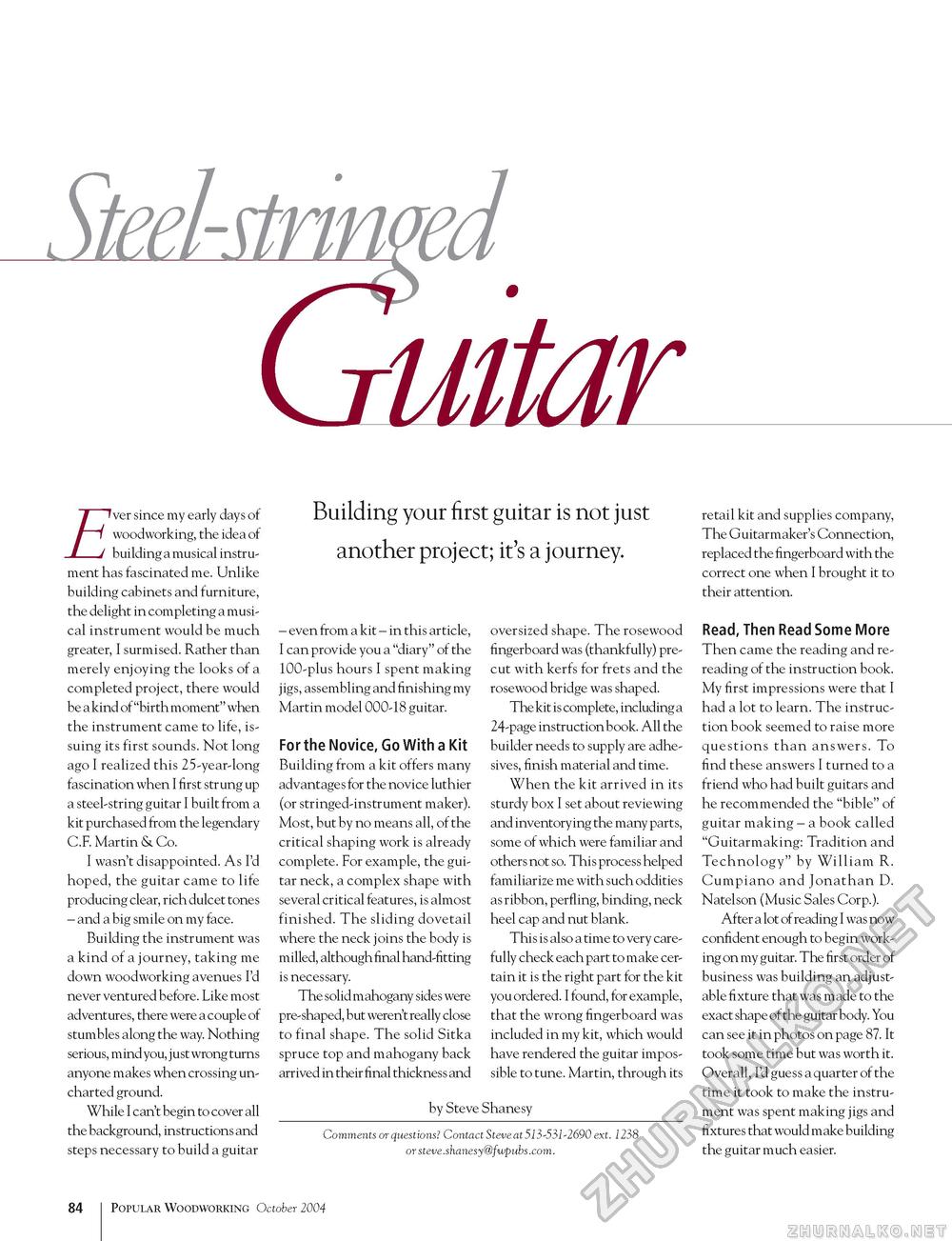Popular Woodworking 2004-10 № 143, страница 87
Steel-stringed Tver since my early days of f T woodworking, the idea of ' / building a musical instrument has fascinated me. Unlike building cabinets and furniture, the delight in completing a musical instrument would be much greater, I surmised. Rather than merely enjoying the looks of a completed project, there would be a kind of "birth moment" when the instrument came to life, issuing its first sounds. Not long ago I realized this 25-year-long fascination when I first strung up a steel-string guitar I built from a kit purchased from the legendary C.F. Martin & Co. I wasn't disappointed. As I'd hoped, the guitar came to life producing clear, rich dulcet tones - and a big smile on my face. Building the instrument was a kind of a journey, taking me down woodworking avenues I'd never ventured before. Like most adventures, there were a couple of stumbles along the way. Nothing serious, mind you, just wrong turns anyone makes when crossing uncharted ground. While I can't begin to cover all the background, instructions and steps necessary to build a guitar Building your first guitar is not just another project; it's a journey. - even from a kit - in this article, I can provide you a "diary" of the 100-plus hours I spent making j igs, assembling and finishing my Martin model 000-18 guitar. For the Novice, Go With a Kit Building from a kit offers many advantages for the novice luthier (or stringed-instrument maker). Most, but by no means all, of the critical shaping work is already complete. For example, the guitar neck, a complex shape with several critical features, is almost finished. The sliding dovetail where the neck joins the body is milled, although final hand-fitting is necessary. The solid mahogany sides were pre-shaped, but weren't really close to final shape. The solid Sitka spruce top and mahogany back arrived in their final thickness and oversized shape. The rosewood fingerboard was (thankfully) pre-cut with kerfs for frets and the rosewood bridge was shaped. The kit is complete, including a 24-page instruction book. All the builder needs to supply are adhe-sives, finish material and time. When the kit arrived in its sturdy box I set about reviewing and inventorying the many parts, some of which were familiar and others not so. This process helped familiarize me with such oddities as ribbon, perfling, binding, neck heel cap and nut blank. This is also a time to very carefully check each part to make certain it is the right part for the kit you ordered. I found, for example, that the wrong fingerboard was included in my kit, which would have rendered the guitar impossible to tune. Martin, through its by Steve Shanesy Comments or questions? Contact Steve at 513-531-2690 ext. 1238 or steve.shanesy@fwpubs.com. retail kit and supplies company, The Guitarmaker's Connection, replaced the fingerboard with the correct one when I brought it to their attention. Read, Then Read Some More Then came the reading and rereading of the instruction book. My first impressions were that I had a lot to learn. The instruction book seemed to raise more questions than answers. To find these answers I turned to a friend who had built guitars and he recommended the "bible" of guitar making - a book called "Guitarmaking: Tradition and Technology" by William R. Cumpiano and Jonathan D. Natelson (Music Sales Corp.). After a lot of reading I was now confident enough to begin working on my guitar. The first order of business was building an adjustable fixture that was made to the exact shape of the guitar body. You can see it in photos on page 87. It took some time but was worth it. Overall, I'd guess a quarter of the time it took to make the instrument was spent making jigs and fixtures that would make building the guitar much easier. 84 Popular Woodworking October 2004 |








